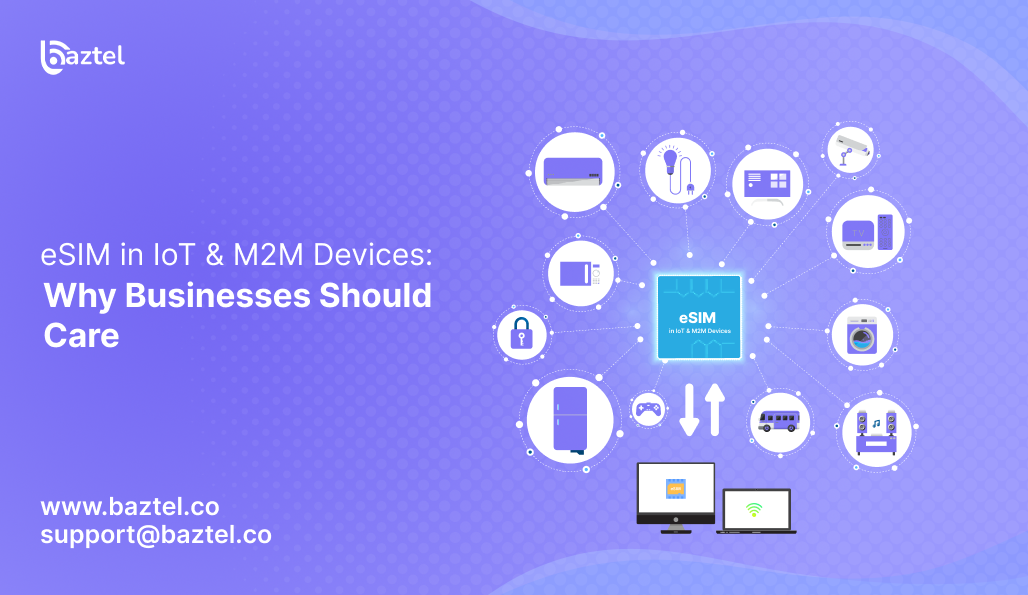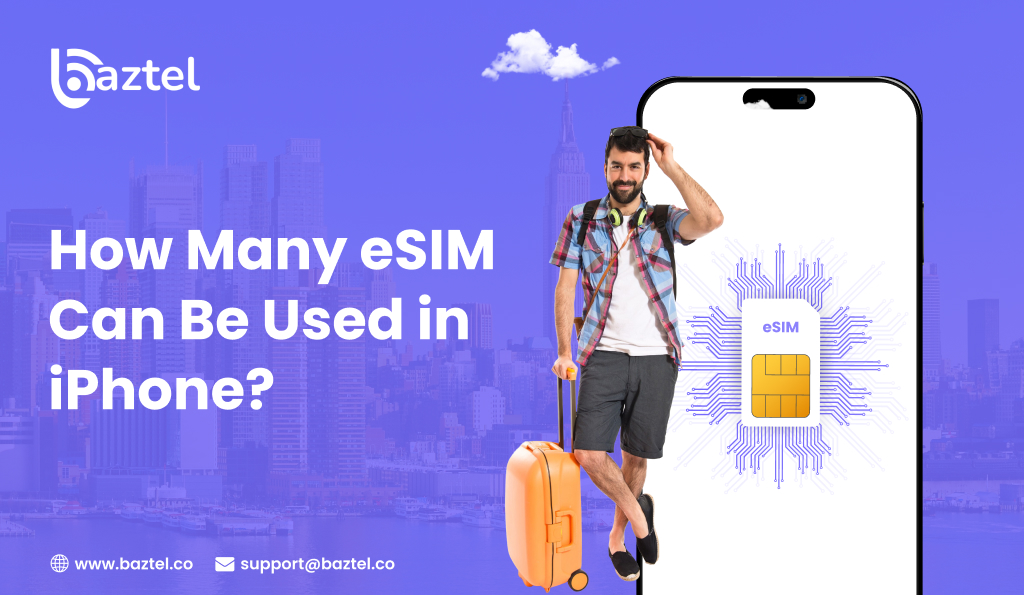Every device around us is getting smarter. A GPS tracker in a truck, a smart water meter, a connected fridge they all need one thing: constant connectivity.
But here’s the problem. Most businesses still rely on physical SIM cards. They work fine for phones. But when you’re handling hundreds or thousands of devices, SIM cards become a headache especially if your devices are spread across cities or countries.
That’s where eSIM makes a big difference. It’s built into the device. No slot, no tray, no handling. You can activate it remotely. Switch networks from your laptop. Track everything from one place.
If you’re in logistics, healthcare, agriculture, or any field that uses IoT or M2M devices, this guide will show you why it’s time to move on from physical SIMsand how eSIM gives your business better control, lower costs, and more flexibility.
What Is eSIM for IoT and M2M?
An eSIM is a tiny chip already built inside the device. You don’t insert it. You don’t replace it. You just scan, activate, and it connects to the mobile network.
For phones, it’s used to avoid physical SIM cards. But in IoT or M2M devices, eSIM does much more. It helps you manage devices remotely. It lets you switch networks in one click. No technician, no field visit.
Say you have smart meters in multiple states. With physical SIMs, you’d have to open every meter. But with eSIM for IoT, you push settings from your system, and it updates across all devices instantly.
It’s not just a SIM replacement. It’s a smarter way to manage connected hardware.
Want to go deeper into business use cases? Read our eSIM for Business blog.
How eSIM Powers IoT Connected Devices
Your devices need to stay online. But they may be in remote fields, moving trucks, or places with patchy networks. That’s where eSIM helps.
It connects your device to the best available network even while moving. You don’t need to insert SIM cards or wait for a signal fix. It just works in the background.
With eSIM connected devices, you can switch networks remotely. No one needs to open the device. No local SIMs needed. Just scan and go.
Say you’re managing 500 smart trackers across 4 countries. Instead of buying SIMs for each location, you install eSIM once. Then push network settings from your dashboard. Done.
It’s faster, cheaper, and works better in real-life business conditions.
Want to explore plans that support travel and roaming? Check this eSIM guide.
Key Benefits of eSIM for M2M and IoT Businesses
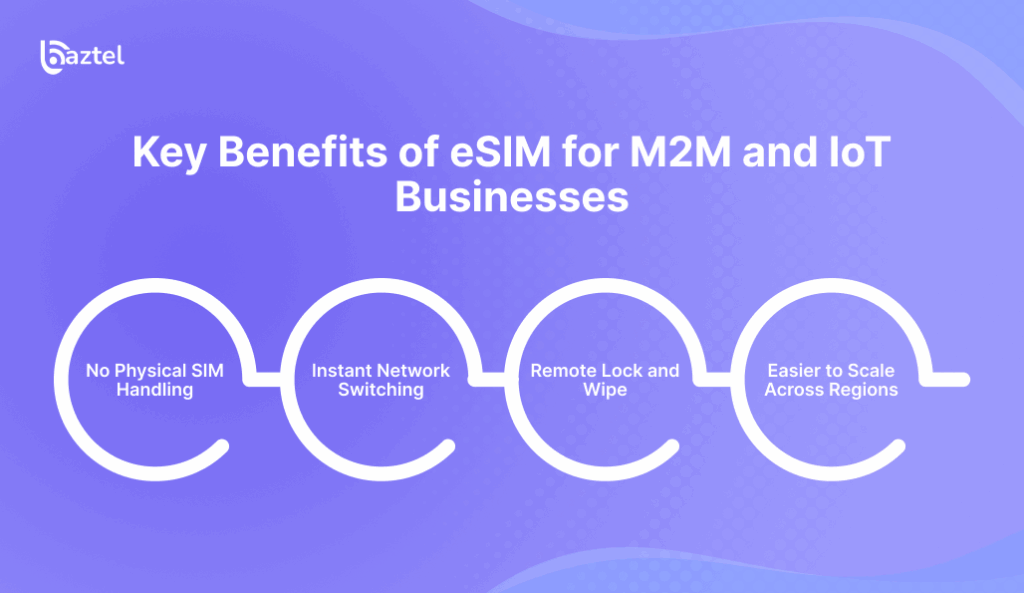
When you manage a fleet, factory, or remote network of sensors, one small SIM issue can create hours of delay. A weak signal, damaged tray, or lost SIM can stop your operations. That’s why businesses are now shifting to eSIM for M2M devices. It gives full control without the headache of manual SIM handling. You can update network settings, check device status, or switch providers remotely from your desk. No field staff. No waiting. No hardware swaps. Over time, you save money, reduce support issues, and make your connected systems more reliable. It’s a smarter way to scale your device network.
If you’re managing devices across countries, our global eSIM plans guide can help.
No Physical SIM Handling
No trays. No packaging. No tools. Just scan and connect. That’s all you need with eSIM. For large-scale deployments, this means fewer steps, fewer errors, and faster rollouts. If your device is sealed, rugged, or installed in a hard-to-reach place, eSIM makes life easier. You don’t open the hardware ever again. And for businesses that manufacture or ship devices in bulk, removing this one physical step saves a lot of time.
Instant Network Switching
Signal drop? No problem. Just push a new profile to the device. With eSIM, switching networks takes minutes, not days. This is perfect for businesses whose devices travel across states or countries. You’re not stuck with one carrier anymore. If one network is weak in an area, your devices can jump to another without anyone touching them. It reduces downtime and improves service reliability.
Remote Lock and Wipe
When devices go missingor land in the wrong handsyou stay in control. You can disable the connection, wipe the eSIM, or switch it off completely. All of this can be done from your system. You don’t need to recover the device physically. This is especially useful for logistics, transport, and outdoor equipment. It also adds an extra layer of security for companies working with sensitive data.
Easier to Scale Across Regions
If your operations are expanding across cities or across borders, eSIM makes scaling easy. You don’t need to manage different SIM cards for each country. Just use one system, one dashboard, and one global plan. You can add new locations without changing hardware. If you’re planning international growth, this is the cleanest way to roll out fast.
Use Cases of eSIM in IoT and M2M Devices
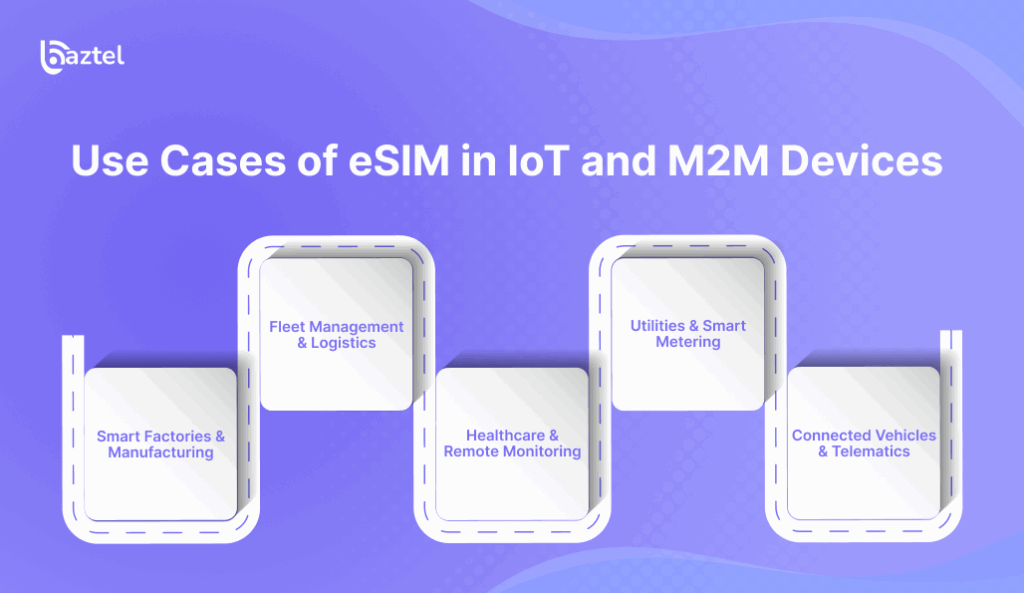
From factories to farms, eSIM connected devices are already doing real work. No need for SIM swapping or on-site visits. Just connect once, and manage everything remotely. That’s why more businesses are moving to eSIMbecause it solves problems that come with scaling.
Whether your devices are on the move, sitting in remote places, or installed in bulk you can keep them connected with one system. No matter the industry, eSIM brings flexibility, speed, and control. It’s not just a telecom upgrade. It’s an operational shortcut.
Want to explore eSIM options that work across borders? Check our top-rated eSIM plans for global use.
Smart Factories & Manufacturing
Machines in modern factories need to talk to each other. They send alerts, track downtime, and log usage in real-time. With eSIM, these machines can stay connected without relying on unstable Wi-Fi or slow physical SIM setups. Everything is configured once and managed remotely.
Fleet Management & Logistics
Trucks and delivery vans cross borders, cities, and network zones daily. With eSIM, your GPS devices, sensors, and driver tablets stay online no matter where they go. You can track fuel use, trip history, or delivery times without network interruptions.
Healthcare & Remote Monitoring
Many hospitals now use wearables and sensors to monitor patients from home. eSIM makes it easy to activate these devices, track data, and update profiles without needing visits or tech setup. It also improves data security and reduces setup delays.
Utilities & Smart Metering
Electric meters, water sensors, and gas trackers often run in remote areas. eSIM lets these devices send usage reports in real-time, without waiting for a technician to fix signal issues. You can switch carriers anytime and reduce outages.
Connected Vehicles & Telematics
Modern vehicles now come with built-in features like real-time location, crash alerts, or remote servicing. With eSIM, these services work even if the car crosses network zones. It also helps carmakers and rental services manage thousands of units from one system.
Security and Compliance in eSIM Connected Devices
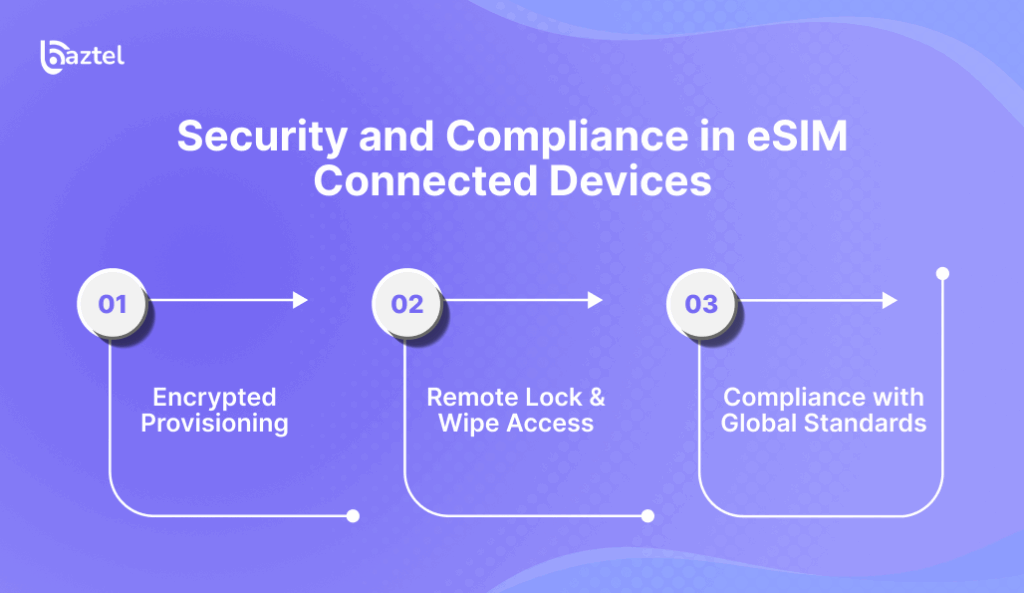
When you’re dealing with real-world devices, trackers, meters, or machines you can’t ignore security. These devices run without human touch. That’s why it’s important to manage them safely, from anywhere.
With eSIM for IoT, you control what connects, when it connects, and how. Every profile is encrypted. You can lock a device. You can wipe it. If something goes wrong, you don’t need to be there physically.
Many providers now follow GSMA remote provisioning standards. This helps you stay compliant even across borders. You also get more visibility. No swapping SIMs means fewer points of failure.
Want to know how this plays out in business? Check out our full eSIM for Business blog for practical examples.
Encrypted Provisioning
Every eSIM profile is protected by encryption. No one can copy, clone, or tamper with it. Your device connects safely even over public networks.
Remote Lock & Wipe Access
Lost device? Stolen unit? One click, and it’s wiped. You can remove the eSIM profile instantly. That means no data leak, no SIM misuse, and no security panic.
Compliance with Global Standards
eSIMs used in enterprise setups now follow GSMA’s guidelines. This helps meet GDPR, telecom laws, and data privacy rules in multiple countries without changing your hardware.
Challenges in Adopting eSIM for IoT
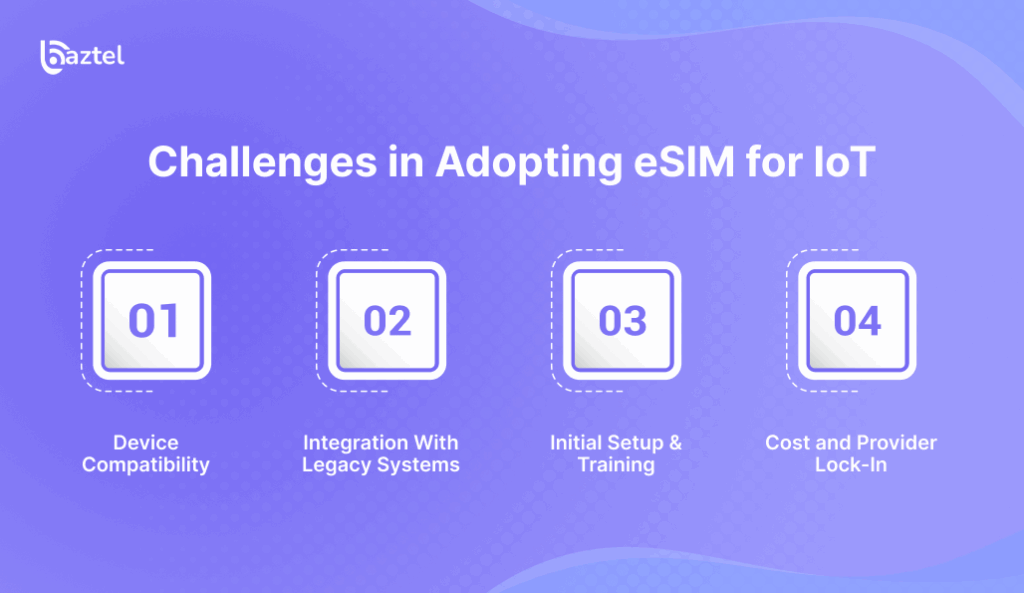
eSIM is powerful, but shifting to it isn’t always simple. Many businesses still run old systems and devices. For them, the change takes planning. Some face compatibility issues. Others worry about cost. A few get stuck with providers that don’t support global rollouts. These challenges are real, but none of them are deal breakers. With the right provider, good testing, and a step-by-step rollout, eSIM for M2M adoption becomes smoother. The key is to prepare early. Check your hardware, software, and carrier options before scaling. Once the foundation is ready, eSIM becomes easier to manage than physical SIM cards ever were.
If you’re new to setup, our activation guide for eSIM is a good place to start.
Device Compatibility
Not every device supports eSIM yet. Older units, or low-cost models, may still rely on plastic SIMs. Before rollout, make a full list of your hardware. Check which ones are compatible and plan upgrades in stages. This avoids failure during deployment and keeps your systems running smoothly.
Integration With Legacy Systems
Many companies already use tools for tracking, billing, or device management. Adding eSIM into these platforms isn’t always straightforward. You may need support from your provider or APIs that connect everything. Doing this upfront ensures your devices talk to your system without downtime.
Initial Setup & Training
Switching from physical SIMs to digital profiles is new for most teams. Training is needed for IT staff and managers. Without proper guidance, mistakes can happen. Providers who offer onboarding support can help your team learn quickly. That way, your first rollout goes without big errors.
Cost and Provider Lock-In
Some eSIM providers tie you to one network. Others add roaming costs that grow over time. Businesses should read the fine print before signing. Always choose a provider with multi-network support. This avoids future costs and keeps your devices flexible.
How to Implement eSIM for IoT and M2M Devices
If you’re moving from physical SIM cards to eSIM, take it slow. Don’t jump into thousands of devices at once. Start with a few. Test how they behave. Learn how your systems handle remote provisioning. Once you’re confident, scale.
The best way to roll out eSIM for IoT is by following a clear plan. Choose compatible hardware, pick a provider who offers support, and connect your systems early. From there, use a central dashboard to push updates, activate devices, or switch networks. This method saves time, cuts costs, and avoids panic in the field.
For a real-world activation checklist, check our eSIM setup timeline guide.
Start With a Small Batch
Begin with 5 to 10 devices. Test them in different conditions. Check how they connect, how fast the provisioning happens, and whether they stay stable. This gives you space to fix errors early. It also helps your team get used to working with eSIM before going large.
Choose a Provider That Supports Remote Profiles
Not all eSIM providers offer full control. Some may need manual support for changes. Pick one that allows over-the-air profile management. This way, you can switch carriers, update plans, and control devices from a single dashboard without raising a support ticket each time.
Integrate With Your MDM or IoT Dashboard
If you already use Mobile Device Management or IoT control panels, check if they support eSIM. The goal is to manage everything from one screen data, device health, signal strength, and network settings. Integration saves time and reduces training needs across teams.
Test Across Multiple Locations
If your devices operate across cities or countries, test them in each region. Different carriers behave differently. Run signal tests, provisioning delays, and connection drop checks. This helps you decide which network profile to push where.
Future of eSIM in IoT and M2M Connectivity
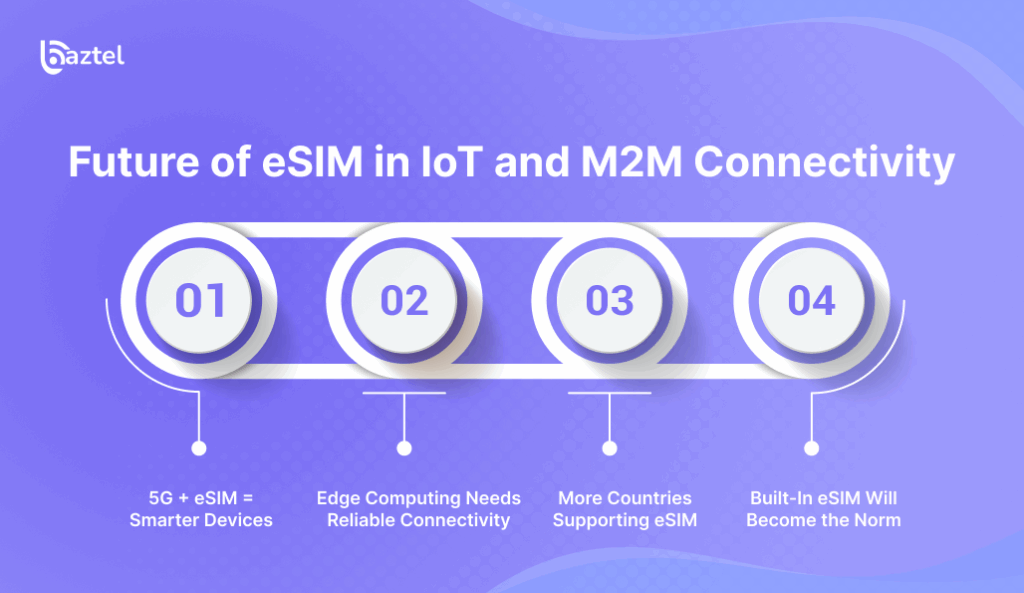
eSIM is already useful today. But over the next few years, it will become the default for connected devices. As networks shift to 5G, and businesses move toward automation, the demand for eSIM connected devices will grow fast.
You’ll see more vehicles, appliances, and machines shipping with built-in eSIM chips ready to connect out of the box. There’ll be fewer SIM trays and more software dashboards. Even governments and telecom regulators are starting to back remote provisioning as a standard.
If you’re planning for long-term growth, this is the right time to build eSIM into your product roadmap. It prepares your systems for future networks, global coverage, and large-scale IoT rollouts.
Explore how business teams are already doing this in our eSIM for Business overview.
5G + eSIM = Smarter Devices
With 5G’s low latency and high speed, eSIM devices will respond faster. This helps in areas like remote healthcare, autonomous fleets, and live video monitoring where every second counts.
Edge Computing Needs Reliable Connectivity
Many companies now process data close to the device itself. This is called edge computing. For this to work, your devices need strong, always-on connectivity. eSIM makes that easier by keeping them linked without manual setup.
More Countries Supporting eSIM
Global rules are catching up. Telecom laws in Asia, Europe, and the Middle East now allow remote provisioning. This means less paperwork, faster rollouts, and more flexibility for businesses launching in new markets.
Built-In eSIM Will Become the Norm
Smartwatches, fitness bands, trackers, and tablets already come with embedded SIMs. Soon, most enterprise hardware will follow. Manufacturers will sell devices that are eSIM-onlyno physical slot, no extra step.
Conclusion: Why Businesses Should Care About eSIM for IoT
If your business runs on connected devices, eSIM isn’t a nice-to-have. It’s a practical upgrade. Whether you’re tracking shipments, managing smart meters, or running remote machines, eSIM for IoT helps you cut delays, lower costs, and stay in control without touching a single SIM card.
You can activate devices remotely, switch carriers anytime, and scale faster across cities or countries. That means fewer errors, faster rollouts, and less pressure on your field team.
If you’re just starting out or planning to switch, our full eSIM for Business guide will help you plan the rollout the right way.
Frequently Asked Questions
1. What makes eSIM better than regular SIM for IoT?
Physical SIM cards need to be handled, inserted, and replaced. That works fine for phones, but not for businesses running smart devices across locations. With eSIM for IoT, you activate everything digitally. No swapping. No courier delays. Just scan and connect. It’s faster, cleaner, and easier to manage when devices are installed in bulk.
2. Can I switch networks with eSIM without touching the device?
Yes. That’s one of the biggest advantages. If your signal drops in one region, you can push a new network profile remotely. It takes minutes. This helps when your devices move around a lot like in transport, delivery, or field service. No site visit needed.
3. Are all M2M devices ready for eSIM?
No. Some older or low-end models still use traditional SIM slots. But most new M2M devices now ship with eSIM support. Before starting, check the tech specs. If your current hardware doesn’t support eSIM, plan your upgrade timeline accordingly.
4. What happens if an eSIM-enabled device is stolen?
You don’t need to panic. You can wipe the eSIM profile remotely. That means the device loses network access and can’t be reused. This gives your business more control, especially if you’re managing sensitive equipment or field units.
5. Can one eSIM provider work across countries?
Yes, if you pick the right one. Many providers now offer multi-country eSIM coverage. You use one dashboard to manage all devices, across all locations. Just make sure your provider supports remote provisioning and fallback networks for each region.
Blog Author
Peter
Peter started BazTel.co to make mobile internet easier for travellers. He noticed how tough it was to find good network options while visiting new countries. That’s when he built BazTel — a place where anyone can buy eSIMs online without confusion or long steps. He believes tech should be simple and useful, not complicated. When he’s free, he likes to travel, test BazTel himself, and keep improving it based on real user problems.

 Botswana
Botswana Zambia
Zambia Congo
Congo Colombia
Colombia China mainland
China mainland Chile
Chile Chad
Chad Central African Republic
Central African Republic Canada
Canada Cameroon
Cameroon Cambodia
Cambodia Burkina Faso
Burkina Faso Bulgaria
Bulgaria Brunei Darussalam
Brunei Darussalam Brazil
Brazil Aland Islands
Aland Islands Bosnia and Herzegovina
Bosnia and Herzegovina Bolivia
Bolivia Belgium
Belgium Belarus
Belarus Bangladesh
Bangladesh Bahrain
Bahrain Azerbaijan
Azerbaijan Austria
Austria Australia
Australia Armenia
Armenia Argentina
Argentina Algeria
Algeria